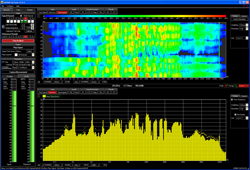
Real-Time Calculations
Since SysTune calculates an IR in real-time, it can also calculate a couple of metrics in real-time which are derived from the IR; Reverb Time (RT) and Speech Transmission Index (STI).
STI is a measure of how well a system under test transmits human speech so that it can be intelligible to a listener.
SysTune will display either RT or MTI (Modulation Transfer Index) and STI as measured in real-time. It will display a curve and give the values at one octave data point intervals from 125 Hz to 8 kHz.
A broadband value for STI is also given. It should be noted that while SysTune implements the calculation of STI per the IEC 60268-16 standard, it does not include correction factors for signal masking and noise levels.
This can be done, however, by saving a measurement in SysTune and opening it in EASERA for more detailed analysis.
The capability of performing IR measurements in real-time can be used in concert with the dual-channel FFT mode to measure the IR, RT and STI of a venue with a full audience present, but without the use of sweeps or noise test stimuli. This can even be done for a purely acoustical performance without the use of a sound reinforcement system!
An actor or soloist may be fitted with a microphone to capture their performance at a relatively close distance. This will serve as the reference signal in SysTune. Several measurement microphones may be placed in the room.
SysTune can then perform all of the measurements of which it is capable. One potential deficiency with this method is that the source for the reference signal (actor/soloist) may not sufficiently excite the system under test at all frequencies of interest. This will result in low coherence values at these frequencies.
SysTune is also capable of measuring, displaying and saving SPL and LEQ histograms. Weighting functions (A, B and C) can be applied to the SPL measurements. These can have a Slow (1 s), Fast (125 ms) or Impulse (35 ms) time constant applied during the measurement. The averaging time for LEQ can be set by the user.
This capability can be useful for doing noise studies over extended periods of time. Noise Criteria (NC) can also be calculated and displayed from a measurement of the ambient noise present. There are many more features to this piece of software that can make it a valuable tool to the electro-acoustical practitioner.
A free demo version of the program can be downloaded from www.easerasystune.com.
Charlie Hughes heads up Excelsior Audio Design & Services; a consultation, design and measurement services company based near Charlotte, NC. Charlie is a member of the AES, ASA, CEA and NSCA. He is an active member of several AES and CEA standards committees.
